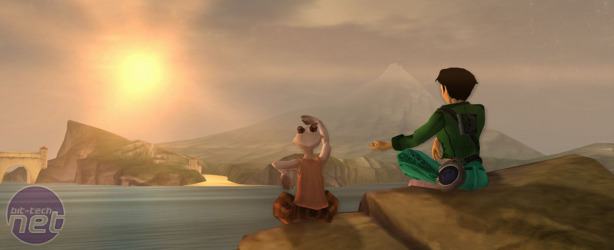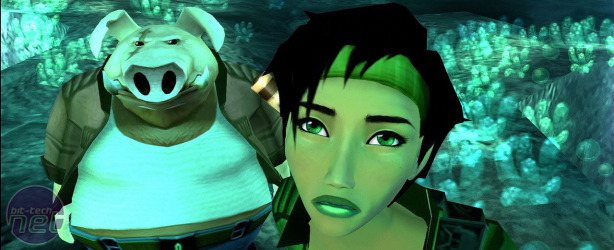
Beyond Good and Evil HD Review
Publisher: UbisoftPlatform: Xbox 360, PlayStation 3
UK Price as reviewed: 800 MS Points (£6.85)
US Price as reviewed: 800 MS Points ($10)
It’s not easy to understand all the hullabaloo over Beyond Good and Evil when you first approach it. At first glance, it’s nought but a standard action-adventure with the palette of a saccharine-sweet kids' cartoon. A jack of all trades, but master of few, Beyond Good and Evil alternates through stealth levels, vehicle combat, action sequences and side-on platforming. Much of the back-story is never explained, and at the same time as telling a moving war story Ubisoft also expects you to never question why your uncle is a talking pig in a leather jacket.
And yet, despite all these apparent flaws and inconsistencies, Beyond Good and Evil has been consistently lauded as one of the best games ever made since it was released in 2003. In fact, the acclaim has been so strong that Ubisoft has seen fit to announce a sequel and an HD remake, despite the commercial failure of the original when it launched.
The reason for this is three-fold. Firstly, while none of the game’s features are strong enough to hold the game up on their own (with the stealth gaming being particularly infuriating at times), none of them are actually bad. That lets them come together to form a single, cohesive whole which feels constantly unique. You’re always jumping from one game-type to the next – stealth to action, action to racing, racing to exploration – and that lends Ubisoft’s unlikely opus a degree of grace.
Secondly, and most visibly, there are the characters themselves, who are so stunningly and believably realised that you can’t help but love them from the start. The central duo, Jade and Pey’j, are an unlikely and instantly sympathetic pair – she's a spry reporter with a penchant for mischief, while he's a mechanic curmudgeon with a heart of gold and a smile in his eye. Together they run an orphanage on the planet Hillys, taking in war orphans whose parents have disappeared in the war with the Domz. Comparing these two with the space marines that any other designer would cast against this backdrop gives the game a kind of strange dignity.
The identity of the alien Domz and their reasons for wanting to crush the Hillyans isn’t ever explained, for the simple reason that this isn’t a game about repelling an alien invasion. Instead, it’s about Jade’s personal journey as she, an investigative reporter, unearths some worrying facts about the Hillyan government. If the stealth and action elements make up the meat of the game, then the backbone is designer Michel Ancel’s recognition that the characters are more interesting than the situation in which they find themselves.
Which leads neatly on to Beyond Good and Evil’s third and most subtle strength; that it has something to say. In an industry full of disposable pleasures and explosive one-off set-pieces, Beyond Good and Evil sets itself apart by using its incredible characters to tell a story of hopeless rebellion. It sounds melodramatic to say that Beyond Good and Evil makes the characters’ search for truth more important than the players’ search for hovercraft upgrades, but it’s valid – and that gives the game a beauty that’s rare to find among shelves stacked with gritty shooters.
Grace, dignity and beauty; that’s what makes Beyond Good and Evil so deserving of all the praise it’s ever received. If you’ve never played it before then it should be regarded as an essential purchase, especially at this price. It may frustrate and confuse you at times – it’s not an easy game to like at first, but it very quickly becomes worth the very little effort required to get into it.
If you have played Beyond Good and Evil before, however, then it’s a different story…

MSI MPG Velox 100R Chassis Review
October 14 2021 | 15:04











Want to comment? Please log in.